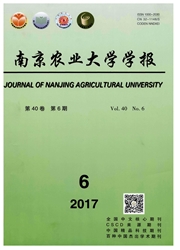

 中文摘要:
中文摘要:
利用RT-PCR和RACE技术获得刀鲚(Coilia nasus)Δ6脂肪酸去饱和酶(Δ6 fatty acyl desaturase,FAD6)的全长cDNA序列2 032 bp,开放阅读框(ORF)为1 338 bp,编码445个氨基酸。其具有3个保守的组氨酸簇(HDXGH、HXXHH和QXXHH)、2个跨膜区和含亚铁血红素结合基序(HPGG)的细胞色素b5结构域等典型的Δ6脂肪酸去饱和酶结构特点。氨基酸同源性分析显示,刀鲚FAD6与海鳗(Muraenesox cinereus)和军曹鱼(Rachycentron canadum)等海水鱼类的相似性达75%~79%,而与淡水鱼类的相似性较低。系统进化分析也显示,其与海水鱼类的亲缘关系较近。荧光定量PCR检测发现该基因在刀鲚脑和肠中高表达,肌肉和肝脏相对高表达,心脏、肾脏和鳃低表达。
 英文摘要:
英文摘要:
The full-length cDNA of Δ6 fatty acyl desaturases(FAD6) of Coilia nasus,which was involved in the biosynthesis of highly unsaturated fatty acids(HUFA),was cloned by RT-PCR(reverse transcription polymerase chain reaction) and RACE(rapidamplification of cDNA ends) methods. The results revealed that the FAD6 cDNA was 2 032 bp,including an ORF(open reading frame) of 1 338 bp specified a protein of 445 amino acids,which contained three histidine-rich regions and two putative transmembrane domains. The deduced amino acid sequence shared 75%-79% identity with that in Muraenesox cinereus and Rachycentron canadum,and low similarity of freshwater fish. Actually,it was consistent with the results of phylogenetic analysis. The tissue-specific expressions of FAD6 mRNAs were detected in C. nasus. A high expression was observed in the brain and intestine, while relatively high expression was encountered in muscle and liver,and a weak expression in the heart,kidney and gill.
 同期刊论文项目
同期刊论文项目
 同项目期刊论文
同项目期刊论文
 期刊信息
期刊信息
